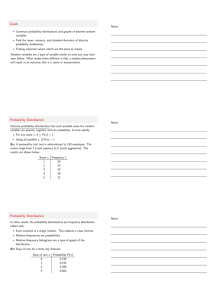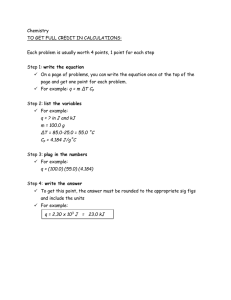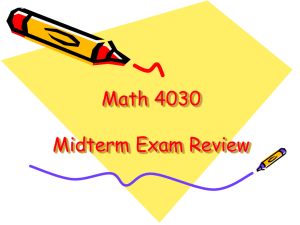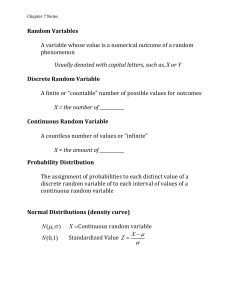Uncertainty, Measurements and Error Analysis – PowerPoint 2015
advertisement
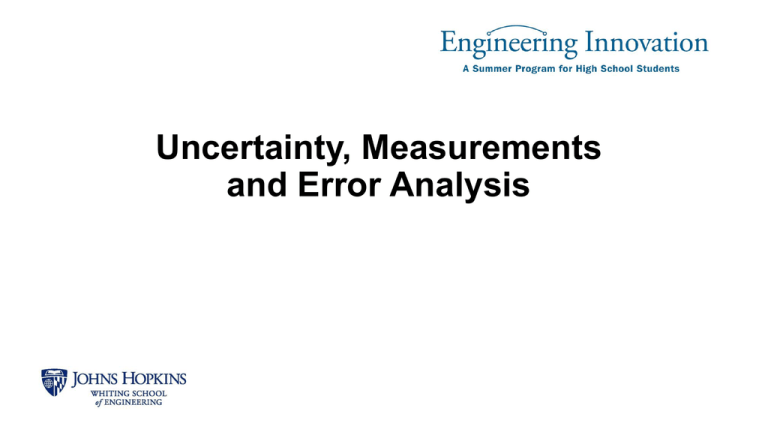
Uncertainty, Measurements
and Error Analysis
Objectives
1.
2.
3.
4.
5.
6.
7.
8.
Statistics
Probability
Normal Distibutions
Mean and Standard Deviation
Measurements
Significant Figures
Accuracy and Precision
Error Analysis
Why Study Statistics?
Statistics: A mathematical science concerned with
data collection, presentation, analysis, and
interpretation.
Economy
Statistics can tell us about…
Sports
http://www.economicpopulist.org/content/peek-employment-reportestablishment-survey
http://espn.go.com/mlb/player/_/id/28513/adam-jones
Population
http://baltimoremaryland.org/history/baltimorepopulation.png
Why Study Statistics?
Statistical analysis is also an integral part of scientific research!
Are your experimental results believable?
Example: Tensile Strength of Spaghetti
Data suggests a relationship between
Type (size) and breaking strength
Why Study Statistics?
Responses and measurements are variable!
Due to…
Systematic Error – same error value by using an instrument the same way
Random Error – may vary from observation to observation
Perhaps due to inability to perform measurements in exactly the same
way every time.
Goal of statistics is to find the model that best describes a target population by
taking sample data.
Represent randomness using probability.
Probability
Experiment of chance: a phenomena whose outcome is uncertain.
Sample Space
Probabilities
Chances
Probability Model
Events
Probability of Events
Sample Space: Set of all possible outcomes
Event: A set of outcomes (a subset of the sample space). An event E occurs if any of
its outcomes occurs. Rolling dice, measuring, performing an experiment, etc.
Probability: The likelihood that an event will produce a certain outcome.
Independence: Events are independent if the occurrence of one does not affect the
probability of the occurrence of another. Why important?
Probability
Consider a deck of playing cards…
Sample Space?
Event?
Set of 52 cards
R: The card is red.
F: The card is a face card.
H: The card is a heart.
Probability?
3: The card is a 3.
P(R) = 26/52
P(F) = 12/52
P(H) = 13/52
P(3) = 4/52
Events and variables
Can be described as random or deterministic:
The outcome of a random event cannot be predicted:
The sum of two numbers on two rolled dice.
The time of emission of the ith particle from radioactive material.
The outcome of a deterministic event can be predicted:
The measured length of a table to the nearest cm.
Motion of macroscopic objects (projectiles, planets, space craft) as predicted by classical
mechanics.
Extent of randomness
A variable can be more random or more deterministic depending on the degree to which
you account for relevant parameters:
Mostly deterministic: Only a small fraction of the outcome cannot be accounted for.
Length of a table - only slightly dependent upon:
• Temperature/humidity variation
• Measurement resolution
• Instrument/observer error
• Quantum-level intrinsic uncertainty
Mostly Random: Most of the outcome cannot be accounted for.
• Trajectory of a given molecule in a solution
Random variables
Can be described as discrete or continuous:
• A discrete variable has a countable number of values.
Number of customers who enter a store before one purchases a product.
• The values of a continuous variable can not be listed:
Distance between two oxygen molecules in a room.
Consider data collected for undergraduate students:
Random Variable
Possible Values
Gender
Male, Female
Class
Fresh, Soph, Jr, Sr
Height (inches)
Integer in interval {30,90}
College
Arts, Education, Engineering, etc.
Shoe Size
3, 3.5 … 18
Is height a discrete or continuous variable?
How could you measure height and shoe size to
make them continuous variables?
Probability Distributions
If a random event is repeated many times, it will produce a distribution of outcomes
(statistical regularity).
(Think about the sum of the dots on two rolled dice)
The distribution can be represented in two ways:
• Frequency distribution function: represents the distribution as the number of
occurrences of each outcome
• Probability distribution function: represents the distribution as the percentage
of occurrences of each outcome
Discrete Probability Distributions
Consider a discrete random variable, X:
f(xi) is the probability distribution function
What is the range of values of f(xi)?
Therefore, Pr(X=xi) = f(xi)
Discrete Probability Distributions
Properties of discrete probabilities:
Pr( X xi ) f ( xi ) 0
k
k
Pr( X x ) f ( x ) 1
i 1
for all i
i
i 1
i
for k possible discrete outcomes
Pr(a X b) F (b) F (a)
f (x )
a xi b
Where:
i
F ( x) Pr( X x)
Discrete Probability Distributions
Example: Waiting for a success
Consider an experiment in which we toss a coin until heads turns up.
Outcomes, w = {H, TH, TTH, TTTH, TTTTH…}
Let X(w) be the number of tails before a heads turns up.
What is the Probability Distribution Function for the sample space?
1
f ( x) x 1
2
f(x)
Pr(a X b) F (b) F (a)
For x = 0, 1, 2….
f (x )
a xi b
k
k
i
Pr( X x ) f ( x ) 1
0.5
0.45
0.4
0.35
0.3
0.25
0.2
0.15
0.1
0.05
0
i 1
0
1
2
3
4
5
6
Number of tails before a heads is tossed
i
i 1
i
Discrete Probability Distributions
Example: Distribution Function for Die/Dice
Distribution function for throwing a die:
Outcomes, w = {1, 2, 3, 4, 5, 6} f(xi) = 1/6 for i = 1,6
0.180
0.160
0.140
0.120
0.100
0.080
0.060
0.040
0.020
0.000
1
2
3
4
5
6
Discrete Probability Distributions
Example: Distribution Function for Die/Dice
Distribution function for the sum of two thrown dice:
f(xi) = 1/36 for x1 = 2
2/36 for x2 = 3
…
0.180
0.160
0.140
0.120
0.100
0.080
0.060
0.040
0.020
0.000
2
3
4
5
6
7
8
9
10
11
12
Cumulative Discrete Probability
Distributions
j
Pr( X x' ) F ( x' ) f ( xi )
i 1
Where xj is the largest discrete
value of X less than or equal to x’
Pr( X xk ) 1
Continuous Probability
Distributions
Properties of the cumulative distribution function:
F () 0
0 F ( x) 1
F ( x) Pr( X x)
F () 1
Properties of the probability density (distribution) function:
b
Pr(a X b) F (b) F (a) f ( x)dx
a
Continuous Probability Density
Function
Cumulative Distribution Function (cdf): Gives the fraction of the total
probability that lies at or to the left of each x
Probability Density (Distribution) Function (pdf): Gives the density of
concentration of probability at each point x
Continuous Probability Distributions
For continuous variables, the events of interest are intervals rather than
isolated values.
Consider waiting time for a bus which is equally likely to arrive anytime in the next ten
minutes:
Not interested in probability that the bus will arrive in
3.451233 minutes, but rather the probability that the bus
will arrive in the subinterval (a,b) minutes:
ba
P(a T b) F (b) F (a)
10
F(t)
1
t
10
Continuous Probability
Distributions
Z
Example: Gaussian (normal) distribution:
Z
X
X
( x )2
1
f ( x)
exp
2
2
2
X Z
( x )2
1
f ( x)
exp
2
2
2
X Z
A normal distribution is described by the mean (μ) and variance (σ2).
Standard normal curve: μ = 0, σ = 1.
Mean, Standard Deviation,
Variance
Mean: The mean is the 1st moment about the origin; the average value of x
( X )
measures the spread of data about the mean.
Standard Deviation: Standard
deviation
N
( X )
N
2
2
Variance: Variance is second moment about the mean; the average squared distance of the d
from the mean.
( X ) 2
2
N
Practice!
Two teams measure the height of a flagpole.
Height in cm
Team A
183
182
185
181
183
184
avg =
183
std dev =
1.41
Team B
183.0
183.5
182.7
182.5
183.1
183.3
avg =
183.0
std dev =
0.37
• Which team did the better job?
• Why do you think so?
Normal / Gaussian Distribution
Normal (Gaussian) Distribution:
Can be used to approximately describe any variable that tends to cluster around the mean.
Central Limit Theorem:
The sum of a (sufficiently) large number of independent random variables will be
approximately normally distributed.
Importance:
Used as a simple model for complex phenomena – statistics, natural science, social
science [e.g., Observational error assumed to follow normal distribution]
Examples of experiments/measurements
that will produce Gaussian distribution?
http://en.wikipedia.org/wiki/Standard_deviation
Standard Error
N
How do we reduce the size of our standard error?
1) Repeated Measurements
2) Different Measurement Strategy
Jacob Bernoulli (1731):
“For even the most stupid of men, by some instinct of nature, by himself and without any
instruction (which is a remarkable thing), is convinced the more observations have been
made, the less danger there is of wandering from one’s goal" (Stigler, 1986).
Moments
Other values in terms of the moments:
Skewness:
3
2 3/ 2
‘lopsidedness’ of the distribution
a symmetric distribution will have a skewness = 0
negative skewness, distribution shifted to the left
positive skewness, distribution shifted to the right
Kurtosis:
Describes the shape of the distribution with respect to the
height and width of the curve (‘peakedness’)
Estimation of Random Variables
Random Variable: a variable whose value is subject to variations due to chance
Assumptions/Procedures
There exists a stable underlying probability density function for the
random variable
Investigating the characteristics of the random variable consists of
obtaining sample outcomes and making inferences about the
underlying distribution
Estimation of Random Variables
Sample statistics on a random variable X
The ith sample outcome of the variable X is denoted Xi
The sample mean : 𝑋 =
2
1
𝑁
The sample variance: 𝑠 =
𝑁
𝑖=1 𝑋𝑖
1
𝑁−1
where N = sample size
𝑁
𝑖=1
𝑋𝑖 − 𝑋
2
𝑿 and s2 are estimates of the mean, , and variance, σ2, of the underlying p.d.f.
𝑋 and s2 are estimates for the sample
and σ2 are characteristics of the population from which the sample was taken
𝑋 and s2 are random variables
Expected Value, E(X)
The value that one would obtain if a very large number of samples were averaged together.
𝐸 𝑋 =
The expected value of the sample mean is the population mean
𝐸 𝑠 2 = σ2
The expected value of the sample variance is the population variance
Expected values allow us to use sample statistics to infer population statistics
Properties of Expected Values
• 𝐸 𝑎𝑋 + 𝑏𝑌 = 𝑎𝐸 𝑋 + 𝑏𝐸 𝑌
where a and b are constants
• If Z = g(X), then E 𝑍 = E[g(X)] =
𝑎𝑙𝑙 𝑣𝑎𝑙𝑢𝑒𝑠 𝑥 𝑜𝑓 𝑋 𝑔
𝑥 𝑃𝑟(𝑋 = 𝑥)
Example: Throw a die. If the die shows a “6” you win $5; else, you lose a $1.
What’s the expected value,E[Z], of this game?
Pr(X=1) = 1/6
Pr(X=2) = 1/6
Pr(X=3) = 1/6
Pr(X=4) = 1/6
Pr(X=5) = 1/6
Pr(X=6) = 1/6
g(1) = -1
g(2) = -1
g(3) = -1
g(4) = -1
g(5) = -1
g(6) = 5
E[Z] = ([(-1)*5*1]/6)+([5*1]/6) = 0, you would not expect to win or lose
Properties of Expected Values
• 𝐸 𝑋𝑌 = 𝐸 𝑋 𝐸 𝑌 where X and Y are independent (samples of X cannot be used
to predict anything about sample Y and Y cannot be used to predict X)
Example: Find the area of a picture with height, X, and width, Y.
Measurements
All measurements have errors
What are some sources of measurement errors?
• Instrument uncertainty (caliper vs. ruler)
• Use half the smallest division (unless manufacturer provides precision information).
L = 9 ± 0.5 cm
L = 8.5 ± 0.3 cm
L = 11.8 ± 0.1 cm
• Measurement error (using an instrument incorrectly)
• Measure your height - not hold ruler level.
• Variations in the size of the object (spaghetti is bumpy)
• Statistical uncertainty
Estimating and Accuracy
• Measurements often don’t fit the gradations of scales
• Two options:
• Estimate with a single reading (take ½ the smallest division)
• Independently measure several times and take an average – try to make each trial
independent of previous measurement (different ruler, different observer)
3.1 ±0.1 cm
http://scidiv.bellevuecollege.edu/physics/measure&sigfigs/C-Uncert-Estimate.html
Accuracy vs. Precision
• Accuracy refers to the agreement between a measurement and the true or
accepted value
• Cannot be discussed meaningfully unless the true value is known or knowable
• The true value is not usually known or may never be known)
• We generally have an estimate of the true value
• Precision refers to the repeatability of measurement
• Does not require us to know the true value
http://www.shmula.com/2092/precision-accuracy-measurement-system
Significant Figures
• Digits that are:
• Actual Measured Values
• Defined Numbers:
• Unit conversions, e.g. 2.54 cm in one inch
• Pi
• e, base of natural logarithms
• Integers, e.g. counting, what calendar year
• Rational fractions, e.g. 2/5
• EXACT NUMBERS HAVE INFINITE NUMBER OF SIGNIFICANT FIGURES
Significant Figures
How many significant digits in each measurement taken with a meter
stick?
Three or four?:
40.05 cm
41.20 cm
42.43 cm
42.72 cm
http://serc.carleton.edu/quantskills/methods/quantlit/DeepTime.html
Significant Figures
• Be clear in your communication
• Which is it?
• 40 cm
• 40.0 cm
• 4 x 101 cm
http://serc.carleton.edu/quantskills/methods/quantlit/DeepTime.html
Significant Figures
• State the number of significant figures:
Value
5280
0.35
0.00307
204100
180.00
Number of significant figures
3 or 4 (unclear)
2
3
4, 5 or 6 (unclear)
5
Significant Figures
• State the number of significant figures for the number described in each
phrase below:
Statement
Number of significant figures
My mattress is 182 inches long
3
My car gets twenty miles per gallon
1 or 2
5280 feet per mile
Infinite – exact number by definition
There are ten cars in that train
Infinite – exact number (assuming you can count to ten accurately)
I am going to the Seven-Eleven
0
Significant Figures
Rounding:
If you do not round after a computation, you imply a greater accuracy than
you actually measured
1. Determine how many digits you will keep
273.92 rounded to 4 digits is 273.9
1.97 rounded to 2 digits is 2.0
2. Look at the first rejected digit
2.55 rounded to 2 digits is 2.6
3. If digit is less than 5, round down
4.45 rounded to 2 digits is 4.4
4. If digit is more than 5, round up
5. If digit is 5, round up or down in order to leave an even number as your
last significant figure
Significant Figures
Rounding after math operations:
• Multiplication or Division
# of sig figs in result is equal to the # of sig figs in least accurate value used
in the computation
273.92 x 3.25 = 890.24; Result is rounded to 890
1/3 x 5.20 = 1.73333; Result is rounded to 1.73
1.97 x 2 = 3.94; Result is rounded to 4
2.0 x Pi = 6.28318...; Result is rounded to 6.3
Significant Figures
Rounding after math operations:
• Addition or Subtraction
Place of last sig fig is important
What’s the problem here?
Significant Figures
Multiple Calculations
• The least error will come from combining all terms algebraically, then
computing all at once.
• If you need to show intermediate steps to a reader, calculate sig figs at
every step. Keep an extra sig fig until the last calculation.
Calculators and significant digits:
Let the uncertain digit determine the precision to
which you quote a result
Calculator:
12.6892
Estimated Error:
+/- 0.07
Quote:
12.69 +/- 0.07
Error Analysis
What is an error?
• No measurements – however carefully made- can be completely free of errors
• In data analysis, engineers use
• error = uncertainty
• error ≠ mistake.
• Mistakes in calculation and measurements should always be corrected before
calculating experimental error.
• Measured value of x = xbest δx
• xbest = best estimate or measurement of x
• δx = uncertainty or error in the measurements
• Experimental uncertainties should almost always be rounded to one sig. fig
• Uncertainty in any measured quantity has the same dimensions as the measured
quantity itself
Error
• Error – difference between an observed/measured value and a
true value.
• We usually don’t know the true value
• We usually do have an estimate
• Systematic Errors
• Faulty calibration, incorrect use of instrument
• User bias
• Change in conditions – e.g., temperature rise
• Random Errors
• Statistical variation
• Small errors of measurement
• Mechanical vibrations in apparatus
Accuracy and Error
• Which type of error, systematic or random?
Systematic
Low Error
Random
Random
Error
• Percent Error
• Relative Error
How do you account for errors in calculations?
• The way you combine errors depends on the math function
• added or subtracted –
• The sum of two lengths is Leq = L1 + L2. What is the error in Leq?
• multiplied or divide –
• The area is of a room is A = L x W. What is error in A?
• other functions (trig functions, power relationships)
• A simple error calculation gives the largest probable error.
Sum or difference
• What is the error if you add or subtract numbers?
x x
y y
z z
w x yz
• The absolute error is the sum of the absolute errors.
w x y z
upper bound
What is the error in length of
molding to put around a room?
• L1 = 5.0cm 0.5cm and L2 = 6.0cm 0.3cm.
• The perimeter is
L L1 L2 L1 L2
5.0 cm 6.0 cm 5.0 cm 6.0 cm
22 cm
• The error (upper bound) is:
L L1 L2 L1 L2
0.5cm 0.3cm 0.5cm 0.3cm
1.6cm
Errors can be large when you
subtract similar values.
• Weight of container = 30 ± 5 g
• Weight of container plus nuts = 35 ± 5 g
• Weight of nuts?
Weight 35 30g 5 g
Error 5 5g 10 g
Result 5 g 10 g 200%
Product or quotient
• What is error if you multiply or divide?
x x
y y
z z
x y
w
z
( x x) ( y y )
w
z z
• The relative error is the sum of the relative errors.
w x y z
w
x
y
z
upper bound
What is the error in the area
of a room?
• L = 5.0cm 0.5cm and W = 6.0cm 0.3cm.
A L W 5.0cm 6.0cm 30.0cm 2
• What is the relative error?
A L W
A
L
W
0.5cm 0.3cm
.15 or 15%
5.0cm 6.0cm
• What is the absolute error?
A A 0.15 30.0cm 2 0.15 4.5cm 2
Multiply by constant
• What if you multiply a variable x by a constant B?
w Bx
• The error is the constant times the absolute error.
w B x
What is the error in the
circumference of a circle?
• C=2πR
• For R = 2.15 ± 0.08 cm
• C = 2 π (0.08 cm)
= 0.50 cm
Powers and exponents
• What if you square or cube a number?
w xn
• The relative error is the exponent times the relative error.
w
x
n
w
x
What is the error in the
volume of a sphere?
• V = 4/3 π R3
• For R = 2.15 ± 0.08 cm
• V = 41.6 cm3
• V/V = 3 * (0.08 cm/2.15 cm)
= 0.11
• V = 0.11 * 41.6 cm3
= 4.6 cm3
Trig Functions
• What if you are using a trigonometric function?
w sin( x )
w sin( x x ) sin( x )
Remote Measurement Lab
“Calculus of Errors” Explanation


